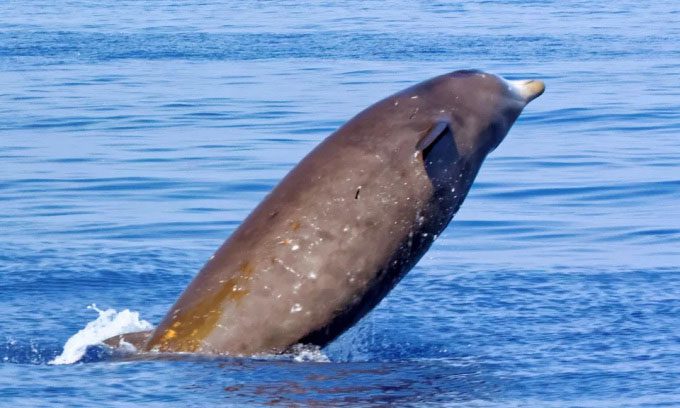The Cuvier’s Beaked Whale can dive as deep as nearly 3,000 meters in low-oxygen conditions, approximately 32 times the height of the Statue of Liberty.
Marine mammals, such as whales and seals, possess special anatomical adaptations that allow them to dive beneath the waves and withstand the immense pressure of the deep sea, while also going without oxygen for relatively long periods. Unlike fish, mammals can only obtain oxygen by breathing air at the ocean’s surface.

The Cuvier’s Beaked Whale is a mammal known for its deepest recorded dives. (Photo: HeitiPaves/Getty)
“For any air-breathing creature that later forages in the deep sea, there is a significant difference that most other animal species do not face. One vital resource, air, is found here, and another vital resource, food, is found elsewhere,” said Nicola Quick, a marine scientist at Duke University.
The title for the deepest diving mammal likely belongs to the Cuvier’s Beaked Whale (Ziphius cavirostris), a medium-sized whale inhabiting temperate and tropical waters. In 2010, researchers began equipping individuals off the coast of California, USA, with satellite tracking devices to record their movements and uncover their remarkable diving capabilities.
One of the eight tagged whales dove to a depth of 2,992 meters, which is about 32 times the height of the Statue of Liberty. Moreover, these whales can dive for extended periods. The research team noted one individual spent over two hours underwater.
In 2020, Quick and colleagues observed a new record when they documented a Cuvier’s Beaked Whale underwater for 3 hours and 42 minutes. This dive was excluded from the official study results due to its occurrence after exposure to sonar (underwater positioning technology using sound waves), which could affect whale behavior. However, the research team acknowledged that such a long dive may represent the actual limits of this species’ diving behavior.
Quick’s research identified three factors that enable whales to execute such impressive dives.
- First, their blood contains high concentrations of myoglobin and hemoglobin proteins, allowing them to store a significant amount of oxygen. Whales can also restrict blood flow to parts of their body to ensure that vital organs receive enough oxygen.
- Second, whales need a slow metabolism to avoid depleting their oxygen supply too quickly. To conserve energy, they often glide while swimming.
- Finally, whales require a method to cope with the pain caused by lactic acid build-up in their muscles while swimming, although Quick is not yet clear on how they achieve this.
Deep-diving mammals must also withstand the pressure at thousands of meters below the water’s surface. The most challenging aspect of maintaining an open airway under high pressure is the lungs, as they are air sacs that can easily collapse under great pressure. However, diving mammals have the ability to flatten their lungs to reduce the air space they must keep open.
Scientists believe that Cuvier’s Beaked Whales dive to forage, but it remains unclear exactly what they consume in such deep waters. A 2017 study suggested that their primary prey consists of squid.
In addition to Cuvier’s Beaked Whales, several other marine mammals can also dive to great depths. For instance, the Southern Elephant Seal (Mirounga leonina) can dive to approximately 2,000 meters, similar to that of the Sperm Whale (Physeter macrocephalus).


















































